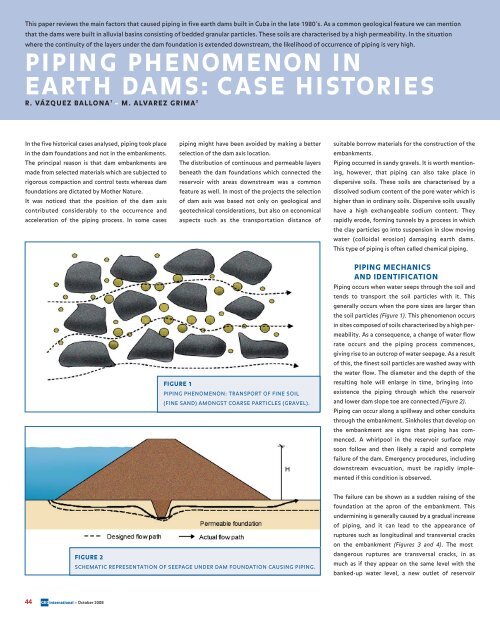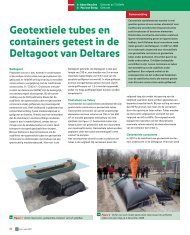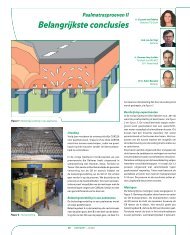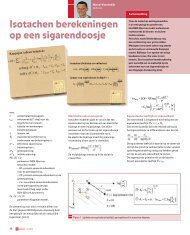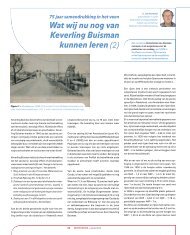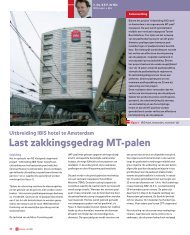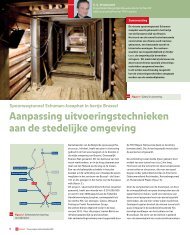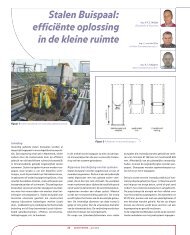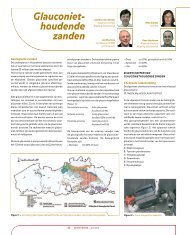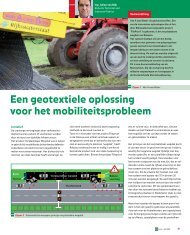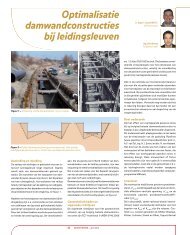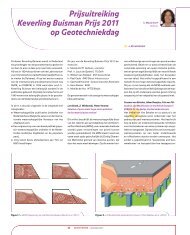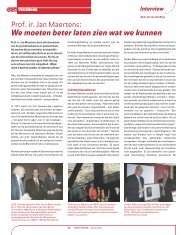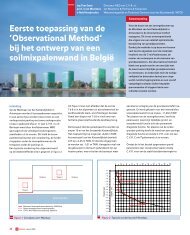i137 GEO binnen - GeoTechniek
i137 GEO binnen - GeoTechniek
i137 GEO binnen - GeoTechniek
Create successful ePaper yourself
Turn your PDF publications into a flip-book with our unique Google optimized e-Paper software.
This paper reviews the main factors that caused piping in five earth dams built in Cuba in the late 1980’s. As a common geological feature we can mention<br />
that the dams were built in alluvial basins consisting of bedded granular particles. These soils are characterised by a high permeability. In the situation<br />
where the continuity of the layers under the dam foundation is extended downstream, the likelihood of occurrence of piping is very high.<br />
PIPING PHENOMENON IN<br />
EARTH DAMS: CASE HISTORIES<br />
R. VÁZQUEZ BALLONA 1 – M. ALVAREZ GRIMA 2<br />
In the five historical cases analysed, piping took place<br />
in the dam foundations and not in the embankments.<br />
The principal reason is that dam embankments are<br />
made from selected materials which are subjected to<br />
rigorous compaction and control tests whereas dam<br />
foundations are dictated by Mother Nature.<br />
It was noticed that the position of the dam axis<br />
contributed considerably to the occurrence and<br />
acceleration of the piping process. In some cases<br />
FIGURE 2<br />
44 <strong>GEO</strong>international – October 2008<br />
piping might have been avoided by making a better<br />
selection of the dam axis location.<br />
The distribution of continuous and permeable layers<br />
beneath the dam foundations which connected the<br />
reservoir with areas downstream was a common<br />
feature as well. In most of the projects the selection<br />
of dam axis was based not only on geological and<br />
geotechnical considerations, but also on economical<br />
aspects such as the transportation distance of<br />
FIGURE 1<br />
PIPING PHENOMENON: TRANSPORT OF FINE SOIL<br />
(FINE SAND) AMONGST COARSE PARTICLES (GRAVEL).<br />
SCHEMATIC REPRESENTATION OF SEEPAGE UNDER DAM FOUNDATION CAUSING PIPING.<br />
suitable borrow materials for the construction of the<br />
embankments.<br />
Piping occurred in sandy gravels. It is worth mentioning,<br />
however, that piping can also take place in<br />
dispersive soils. These soils are characterised by a<br />
dissolved sodium content of the pore water which is<br />
higher than in ordinary soils. Dispersive soils usually<br />
have a high exchangeable sodium content. They<br />
rapidly erode, forming tunnels by a process in which<br />
the clay particles go into suspension in slow moving<br />
water (colloidal erosion) damaging earth dams.<br />
This type of piping is often called chemical piping.<br />
PIPING MECHANICS<br />
AND IDENTIFICATION<br />
Piping occurs when water seeps through the soil and<br />
tends to transport the soil particles with it. This<br />
generally occurs when the pore sizes are larger than<br />
the soil particles (Figure 1). This phenomenon occurs<br />
in sites composed of soils characterised by a high permeability.<br />
As a consequence, a change of water flow<br />
rate occurs and the piping process commences,<br />
giving rise to an outcrop of water seepage. As a result<br />
of this, the finest soil particles are washed away with<br />
the water flow. The diameter and the depth of the<br />
resulting hole will enlarge in time, bringing into<br />
existence the piping through which the reservoir<br />
and lower dam slope toe are connected (Figure 2).<br />
Piping can occur along a spillway and other conduits<br />
through the embankment. Sinkholes that develop on<br />
the embankment are signs that piping has commenced.<br />
A whirlpool in the reservoir surface may<br />
soon follow and then likely a rapid and complete<br />
failure of the dam. Emergency procedures, including<br />
downstream evacuation, must be rapidly implemented<br />
if this condition is observed.<br />
The failure can be shown as a sudden raising of the<br />
foundation at the apron of the embankment. This<br />
undermining is generally caused by a gradual increase<br />
of piping, and it can lead to the appearance of<br />
ruptures such as longitudinal and transversal cracks<br />
on the embankment (Figures 3 and 4). The most<br />
dangerous ruptures are transversal cracks, in as<br />
much as if they appear on the same level with the<br />
banked-up water level, a new outlet of reservoir


